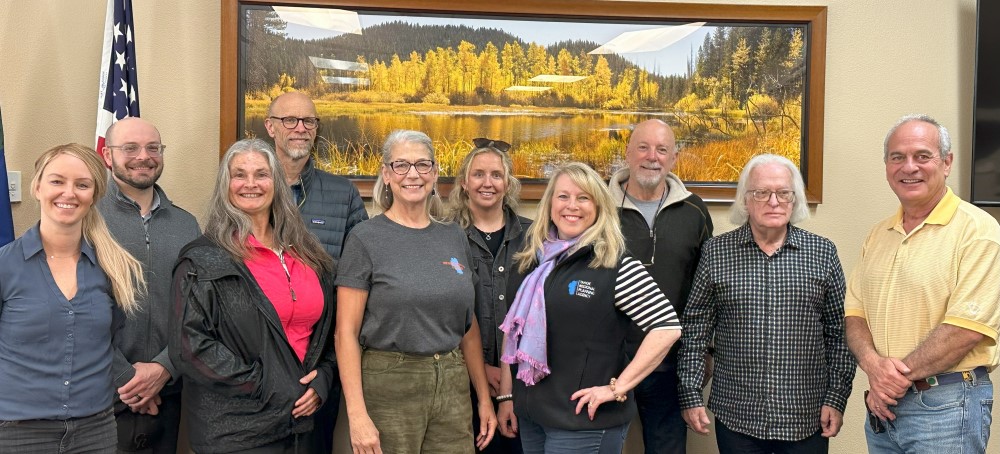By Julie Regan
 This summer I had the pleasure of meeting with community members around the lake through a series of TRPA Talks that were both enlightening and inspiring. As I approach completion of my first year as Executive Director of the Tahoe Regional Planning Agency (TRPA), I am reflecting on the issues that are top of mind in our community and am grateful for the kindred spirits that are passionate about Lake Tahoe.
This summer I had the pleasure of meeting with community members around the lake through a series of TRPA Talks that were both enlightening and inspiring. As I approach completion of my first year as Executive Director of the Tahoe Regional Planning Agency (TRPA), I am reflecting on the issues that are top of mind in our community and am grateful for the kindred spirits that are passionate about Lake Tahoe.
The talks were enlightening because I was able to see the connections that TRPA’s work has to our communities’ and the lake’s greatest needs; and inspiring because, even though I have been at TRPA for 20 years, I was reminded how critical the agency’s role in the region remains.
Just as the Lake Tahoe Basin is connected environmentally, our communities are experiencing many of the same challenges from north to south and east to west around the basin. While the concerns are significant, so is the common ground from which we can build. There is also significant alignment between concerns and TRPA’s strategic priorities set by our volunteer 15-member Governing Board.
Tahoe Living
The shortage of affordable housing was part and parcel of every talk. The housing crisis is harming the lake as more workers commute into the basin, and as I heard from many of you, it is impacting the fabric of our communities. TRPA and our housing partners are bringing forward solutions in many shapes and sizes, from subsidized, deed-restricted workforce housing projects to regional changes to encourage these privately funded projects. In our role as the region’s bi-state land-use agency, TRPA is updating policies to encourage more affordable and workforce housing investments that also bring water quality and transportation improvements.
This fall, TRPA planners are bringing forward targeted improvements to design standards such as land coverage, building height, and allowed density that will lower the cost to build multi-family housing for local workers. These changes would only apply to deed-restricted homes. Modernizing our land-use policies is an important step, but much larger solutions are needed. TRPA will be scaling up in the coming year to address equity issues and build the region’s capacity to deliver both housing and climate change solutions.
Keeping Tahoe Moving
Traffic congestion on the basin’s roadways is a concern we all share. Transportation is a cross-cutting issue where concerns about air and water quality, safety, equity, tourism, and climate resilience come together. Through the Lake Tahoe Environmental Improvement Program, basin partners have completed significant bike and pedestrian, transit, and roadway safety improvements in recent years. Each of these projects brings the vision of a safe and interconnected transportation system closer to reality. TRPA is helping increase the pace of projects coming forward by leading broad-based coordination among corridor management agencies and bringing millions of dollars to the basin from federal and state grants.
The bi-state compact that formed TRPA more than 50 years ago envisioned the kind of partnership we are leading in transportation today. In Tahoe’s most visited recreation corridors, partners are implementing projects to reduce roadside parking, increase transit and trail use, and lay the framework for reservation systems to better manage peak demand.
Restoration and Reilience
With the news of the devastating wildfires in Maui, emergency response and evacuation preparedness are a top priority for everyone who lives in a fire-prone area like Lake Tahoe. Partners on the Tahoe Fire and Fuels Team have so far treated 92,000 acres of forest and conducted more than 63,000 defensible space evaluations to reduce the threat of catastrophic wildfire to our communities. Some of this work helped save Lake Tahoe from the Caldor Fire in 2021 that led to the evacuation of more than 30,000 people from the South Shore.
In partnership with the Tahoe Fire and Fuels Team, TRPA is taking part in communication and coordination work among emergency management agencies. Like the improvements TRPA helped make after the 2007 Angora Fire, staff is working with basin fire chiefs post-Caldor Fire to find new ways to improve coordination. The top priority for TRPA is to continue supporting major forest health and resilience projects, including those that help keep evacuation corridors safe.
These are a few of the connections I made during our TRPA Talks this year and I look forward to more as the leaves continue to turn and we head into the winter season. I want to thank everyone who came out for sharing your stories and suggestions. To stay up to date on our strategic priorities and future TRPA talks, sign up for our eNews.
Julie Regan is Executive Director of the Tahoe Regional Planning Agency

